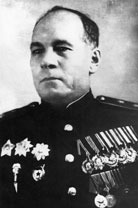
The Soviet Airborne Forces or VDV was a separate troops branch of the Soviet Armed Forces. First formed before the Second World War, the force undertook two significant airborne operations and a number of smaller jumps during the war and for many years after 1945 was the largest airborne force in the world. The force was split after the dissolution of the Soviet Union, with the core becoming the Russian Airborne Forces, losing divisions to Belarus and Ukraine.
The 4th Airborne Corps was an airborne corps of the Red Army in World War II. It fought in the Vyazma airborne operation, an unsuccessful landing during the Rzhev-Vyazma Offensive.

The 4th Guards Airborne Division was an airborne division of the Red Army that fought as infantry during World War II.
The 13th Guards Airborne Division was a division of the Soviet Airborne Troops.
The Soviet Airborne Troops formed a number of Airborne Corps during World War II.
The 2nd Guards Airborne Division was a division of the Red Army during World War II.
The 3rd Guards Airborne Division was a Red Army division of World War II. In December 1945 it appears to have become 125th Guards Rifle Division, while serving with 35th Guards Rifle Corps, 27th Army, Carpathian Military District.
The 32nd Guards Tank Division was a tank formation of the Soviet Army/Soviet Ground Forces. Its predecessor, the 9th Guards Airborne Division, was a Red Army Airborne division of World War II. On 19 June 1945, it became the 116th Guards Rifle Division. In 1946, it became the 14th Guards Mechanized Division. In 1957, it became the 14th Guards Motorized Rifle Division. In 1982, it became the 32nd Guards Tank Division, which was disbanded in June 1989.
The 126th Guards Rifle Division was a Red Army division from 1945 to 1946, part of the Southern Group of Forces. The 126th Guards Rifle Division was originally the 10th Guards Airborne Division, which was transformed into a rifle division on 20 December 1945.

The 104th Guards Airborne Division was a division of the Soviet Airborne Troops during the Cold War that briefly became part of the Russian Airborne Forces after the dissolution of the Soviet Union. It was originally formed as the 11th Guards Airborne Division during World War II. In December 1944, the 11th Guards Airborne Division became the 104th Guards Rifle Division. On 7 June 1946, the division was renamed the 104th Guards Airborne Division. It was reduced to the 31st Guards Airborne Brigade in May 1998.
The 11th Guards Airborne Division was the name of two separate airborne divisions of the Soviet Airborne Troops. The division was first formed in late 1943 from three airborne brigades and did not see action before its conversion to the 104th Guards Rifle Division nearly a year later. The division was formed a second time in 1948 from a regiment at Ryazan and was disbanded in 1955.
The 105th Guards Airborne Division was an airborne division of the Soviet Airborne Troops.

Ivan Ivanovich Zatevakhin was a Red Army Lieutenant general who commanded the Soviet Airborne Forces (VDV) from 1944 to 1946.

Alexander Fyodorovich Kazankin was a Red Army Lieutenant general who commanded the Soviet airborne. He fought in the Russian Civil War and graduated from the Frunze Military Academy in 1934. Kazankin led the 4th Airborne Corps during the Vyazma airborne operation. He later commanded the 1st Guards Airborne Division, 16th Guards Airborne Division, 12th Guards Rifle Corps and 39th Guards Rifle Corps. Kazankin became the Soviet airborne commander in October 1947, but was demoted to deputy commander in December 1948. After briefly becoming airborne forces commander again between January and March 1950, Kazankin successively became inspector general of the airborne forces and then deputy airborne forces inspector general before his death on 20 March 1955.
The 3rd Airborne Corps was an airborne corps of the Red Army in World War II. The corps was established near Kyiv.
The 37th Guards Rifle Division was an infantry division of the Red Army which fought during World War II.
Viktor Grigoryevich Zholudev was a Red Army major general and posthumous Hero of the Soviet Union. Zholudev fought in the 1929 Sino-Soviet conflict, the Battle of Lake Khasan in 1938 and the 1939 Battles of Khalkhin Gol, as well as World War II. Zholudev commanded the 37th Guards Rifle Division during its defense of the Stalingrad tractor factory during the Battle of Stalingrad.
The 2nd Airborne Corps was a corps of the Red Army during World War II. It fought in the Battle of Kiev. In the summer of 1942, the 2nd Airborne Corps became the 32nd Guards Rifle Division.
The 1st Guards Tank Division was a tank division of the Soviet Army from 1945 to 1947, stationed in Neuruppin. It was formed in the spring of 1942 as the 26th Tank Corps. The corps fought in Operation Uranus and became the 1st Guards Tank Corps, being redesignated as a reward for its actions in December 1942. It fought in Operation Gallop, the Third Battle of Kharkov, Operation Kutuzov, Operation Bagration, the East Prussian Offensive, the East Pomeranian Offensive and the Berlin Offensive. During the East Prussian Offensive, the division captured Mława, Działdowo and Płońsk and was awarded the Order of Lenin for its actions. The division had been awarded the honorific "Don" for its actions in Operation Gallop. It also was awarded the Order of the Red Banner and the Order of Suvorov 2nd class.
The 212th Airborne Brigade was an airborne brigade of the Soviet Airborne Troops, formed twice.




